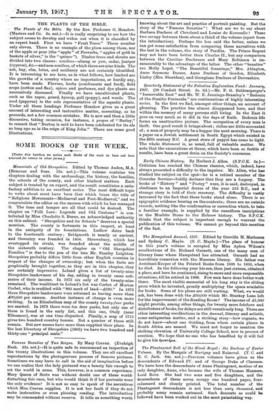THE PLANTS OF THE BIBLE.
. The Plants of the Bible. By the Rev. Professor G. Henslow. (Masters and Co. Os. net.)—It is really surprising to see how the 'subject seems to develop and widen out when it is classified by an expert hand. First we have "Fruit Trees." These number only eleven. There is no example of the plum among them, nor of the apple or pear (the "apple" of Proverbs, "apples of gold in baskets of silver," is the "quince"). Timber trees and shrubs are divided into two classes : conifers—almug or yew, cedar, juniper (cypress), Ac.—and non-conifers, of which there are nine kinds. The 'ash, bay, elm, lotus, and mulberry are not certainly identified. It is interesting to see here, as in what follows, how limited are the growths of a country where no importations, or hardly any, ' have been made. Flowers, herbs (condiments and food), field crops (cotton and flax), spices and perfumes, and dye plants are successively discussed. Finally we have uncultivated plants, . such as the caper, gourd, hyssop, gall (poppy), and weeds. The reed (papyrus) is the sole representative of the aquatic plants. Under all these headings Professor Henslow gives us a great -amount of interesting and instructive matter, correcting, as be .proceeds, not a few common mistakes. He is now and then a little discursive, taking occasion, for instance, is propos of "Barley," to remark that "Barton is said to have been celebrated for its ale as long ago as in the reign of King John." There are some good . illustrations.






































 Previous page
Previous page